What is indoor seed starting? Why is indoor seed starting often needed in gardening? How to get started with growing seeds indoors
Ferry-Morse Home Gardening Blog | September 2021
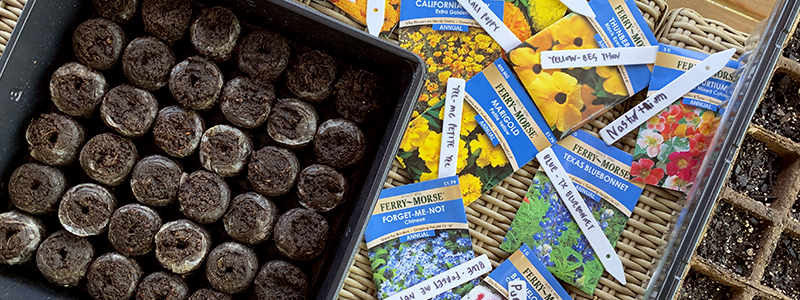
A Jiffy seed starting peat pellet greenhouse sits at the ready, waiting for some Ferry-Morse flower seeds to be started.
In indoor seed starting, timing is everything.
Gardening success often relies upon good timing.
Start a plant too early, and it might peak before it has a chance to seize the intended moment. Begin too late and risk missing optimal outdoor growing conditions.
In its gentle way, gardening teaches us the art of good timing, especially in seed starting.
Seeds started within the ideal range of time allow you to grow plants strong enough to handle the outdoors but not so overgrown in their beginnings that they falter before missing their ideal transplant window.
In this article, we'll cover what indoor seed starting is, why it’s practiced, and finally explain how to start seeds indoors in enough time to move them into your garden, where they will be ready to handle the sun, wind, and rain. Let's dig in!
What is indoor seed starting?
Indoor seed starting is the practice of sowing your seeds inside of your home, garage, greenhouse, etc. to get a jump-start on reaching a plant’s maturity while waiting for its optimal growing conditions to commence outdoors.
The process of seed starting is meant to mimic a seeds’ ideal germination and growing environment to produce young plants weeks—or months—before it’s safe to transplant them to garden beds or containers outside.
Why is indoor seed starting needed in gardening?
Starting seeds indoors gives gardeners a “leg-up” in the outdoor growing season because it adds days to weeks to the conditions plants need to adequately mature throughout their growing season.
In many areas in the US, a plant's time to maturity may not align with the outdoor growing season because temperatures are either too cold or too warm for short or extended periods. Which, for many plants, can be detrimental to their growth.
In other words, plants need enough time and specific conditions to flourish and grow to maturity. If the outdoor growing season in your area doesn’t allow for this timing, indoor seed starting will enable you to make up for it.
Keep reading for an example.
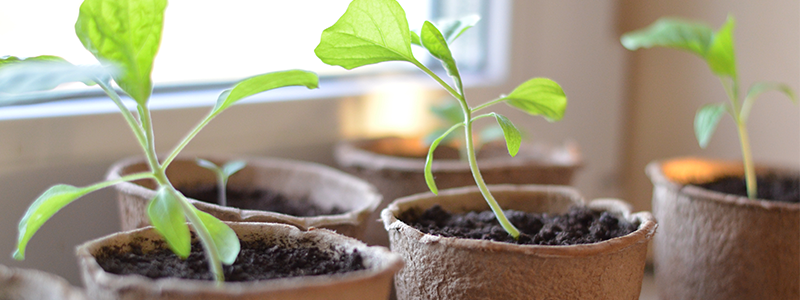
Eggplant seedlings growing in seed starting pots located in front of a sunny window indoors.
Let's run through an example of growing eggplant in the spring in Omaha, Nebraska.
Heirloom Black Beauty Eggplant requires about 12 weeks to mature, and Omaha's last frost date is April 27th. Omaha's local extension office tells us this is a warm-season vegetable, its seeds germinating best at temperatures above 70°F.
The seed packet instructs us to start seeds indoors 8–10 weeks before planting outdoors. In addition, to wait three weeks after the last spring frost date to transplant them, which would be around May 18th.
So, count back 8–10 weeks from May 18th, and we arrive at the date range of March 9th–23rd. We will need to sow our seeds indoors during this period.
In addition, in May, Nebraska's temperature averages 72°F, going up to 87°F in July and then drops below 70°F in October.
So what does all this mean?
To summarize, we would grow our eggplant in Omaha in the spring as follows:
- Sow seeds indoors from March 9th–23rd, most likely using a heating mat to achieve the required temperature for germination
- Transplant seedlings to the outdoor garden around May 18th, pending favorable conditions outdoors
- Avoid waiting too late in the growing season to start this vegetable in this zone because below-optimal temperatures will inhibit growth as the outdoor growing window tapers off to a cold close
Accommodating a plant’s maturity date is only one of the benefits of indoor seed starting.
Starting seeds in a sterile seed starting mix supported by heat mats and seed trays improves their germination rate significantly.
Furthermore, some seeds are simply too tiny to germinate successfully outdoors, like begonia and heuchera. A fun fact is that orchids have the smallest seeds of all flowering plants.
But wait, there's more! Starting plants from seeds gives you access to enjoying more varieties in your garden as only a limited number of plants are available as transplants.
So, overall, starting seeds indoors is an inexpensive way to grow your own transplants and have more control over what you want to enjoy in your landscape and garden!
When should I start my seeds indoors?
Time the sowing of your seeds indoors according to the following:
- Each plant’s maturity date
- Its requirements for growing
- Your region's outdoor growing window
Keep these factors in mind, and you'll be able to grow seedlings just fine. Here are some guidelines and resources to help.
Maturity date
Instructions on the seed packet tell you the number of days to maturity for a plant. Instead of the word “maturity,” you might see "days to harvest" or "days to bloom."
For example, Heirloom Black Beauty Eggplant's instructions state, "Days to Maturity: 85 Days." Keep in mind that seed packet instructions might only list the "days to germination," particularly for flowers.
Requirements
The seed packet also lists a plant's specifications for growing, including if you should sow seeds indoors or outdoors and the best time to transplant seedlings started indoors.
Outdoor growing window
The time between a zone's last spring frost date and first fall frost date is its outdoor growing window, also known as its growing season. Essentially, it's the time of year when outdoor temperatures are not prohibitively cold for growing a flower or vegetable garden.
These windows vary across the U.S., with some experts in southern growing zones declaring two growing seasons on either side of the region’s intense summer heat! The secret is understanding that the window in your zone will lead to better gardening success depending on the type of plant you want to grow.
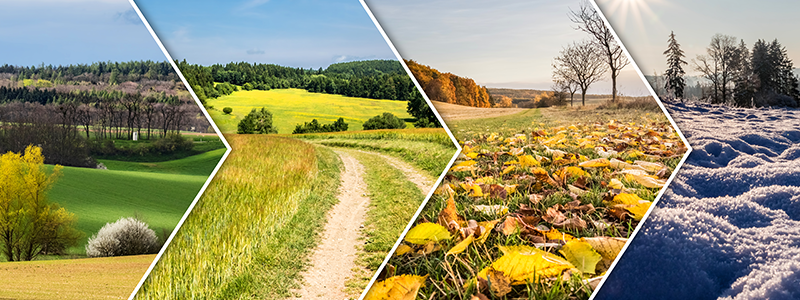
A depiction of seasonal transitions throughout the U.S. — spring, summer, fall, winter —
different regions will experience different lengths of time in which they can grow a garden successfully outdoors.
How do I calculate my growing window?
Almanac.com has a wonderful calculator to help you determine frost dates and the number of days in between that comprise your outdoor growing window. You can use CalculateMe.com to convert days to weeks, making it easier to count time on a calendar.
For example, the average last spring frost date for Omaha, Nebraska, is April 27, and its first fall frost date is October 5, which means the area has about a 23-week growing window.
Keep in mind that these 23 weeks encompass the cool months of spring, leading into the hot months of summer and then returning to cooler weather in September and October. It's essential to know these temperature fluctuations to start your cool-season and warm-season plants at the proper time.
It's also worth your time to find out your growing zone as listed on the EURA Plant Hardiness Zone Map because it helps you determine which plants are most likely to thrive at your location.
How do I start my seeds indoors?
The best way to germinate seeds indoors is to:
- Obtain viable seeds from a reputable supplier
- Have the right supplies and equipment to produce optimal conditions for germination
Obtain viable seeds
Find a supplier that provides viable seeds that are clean and free of disease. Also, find seeds that are less than a year old. Older seeds can germinate, but the percentage that does so will most likely be less.
Use the right tools and accessories for the job
A few tools will help you start seeds successfully. Let’s dig a little deeper.
Grow lights and heat mats: Heat mats help you control the temperature to germinate seeds. After germination, grow lights ensure seedlings’ vigorous growth until transplant time.
Peat pellet greenhouses: Peat pellets make transplanting a breeze, even for plants with fussy roots. The greenhouse comes with a plastic lid that traps moisture while allowing light to reach the seedlings. And the best part is that we’ve already put together step-by-step instructions on setting up a seed-starting greenhouse.
Peat strips and trays: These biodegradable, sustainably sourced containers consist of Canadian sphagnum peat moss and wood pulp. They are super-easy to use and, when outdoor conditions are favorable, can be placed—seedling and all—directly in outdoor garden soil.
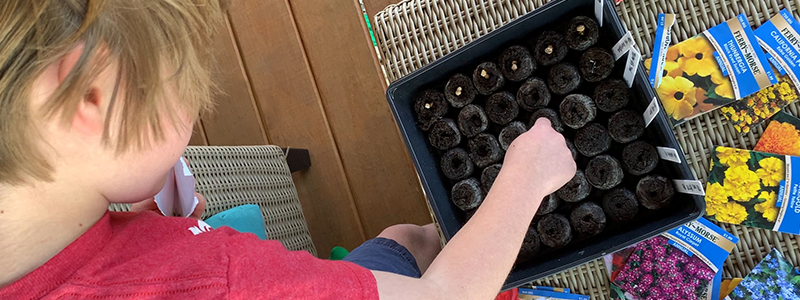
A young gardener starts annual flower seeds in a Jiffy peat pellet greenhouse.
So, this is great! Now can I start any plant I want indoors?
Technically, you can start any plant you want indoors, but that doesn’t mean you should — and here’s why: some plants do not transplant well, and your growing window might be long enough to direct sow those plant seeds outdoors.
Vital factors to always consider are the temperature the plant needs, its root transplant tolerance, and your outdoor growing window.
So, if you want to grow a plant that takes 130 days to reach maturity and your outdoor growing window is only 100 days long, then you'll want to start those seeds indoors to maximize the time required to grow the plant to maturity.
Again, plants with sensitive roots do not transplant well and grow best as direct-sow seeds. Although, you can start them in peat pellets or biodegradable pots to avoid disturbing their roots. Examples of root-sensitive plants include beans, cilantro, pumpkins, and watermelon.
On the other hand, plants that transplant well include brassicas, collards, marigolds, onion, peppers, tomatoes, and zinnias. Learn more about direct seeding vs. transplanting.
Timing helps us in gardening and life!
There you have it, starting seeds is a common practice in gardening for several reasons. It's a great introduction to the many time-sensitive tasks involved in gardening—for beginner gardeners especially.
Most importantly, timing reminds us to strive for balance and provides us with patience and wisdom that extends beyond the seed-starting tray.
Enjoy your seed starting adventures and as always, lean on us for support when needed because we're always here to ensure your gardening journey is a successful and enjoyable one!
CLICK HERE TO EXPLORE THE REST OF THE FERRY-MORSE GARDENING BLOG -->

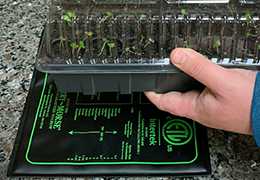
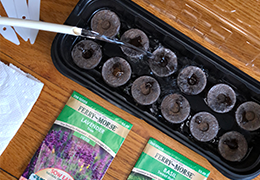
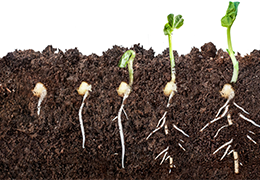
Forgot to add that I do transplant the seedlings into 4×4 square containers before I start the outdoor hardening. I rest them without the lights for a day before they go back under lights. Don’t worry about keeping the seedlings warm once they have their first set of leaves. If they are colder at night (we keep our house at 62 in the winter), they will be stockier. Also – don’t keep them too far away from the lights at first when they sprout.
I have been using the Ferry Morris Tomato Vegetable greenhouses, with heating mats to start my tomato, pepper and zinnia seedlings for 8 years now. They work like a charm. I live in Kansas City and mid February for peppers (longer germination) and first of March for tomatoes works best for me. Seedlings sprout in about 7 days with the heat mats. Once they sprout I transfer the pods from the covered 9×4 to the 4×4 bases from previous years and place them 5 to 6 inches under either T5 or LED multi spectrum lights. I water the pods before they dry out – about 1 week after removing the dome. Once I have the second set of true leaves I start putting the seedlings outside – first on cloudy days with no wind, then gradually add hours per day as I can, to strengthen the stems. I try to start planting outdoors end of April and finish end of May. I aim for 70 tomato plants and 30 peppers each year and usually end up with give away seedlings as the pods are very successful in achieving germination. I wouldn’t use anything else!
Should I use the dome from the Pro-Hex Kit on the grow light after planting the seeds?
Based on the information you provided, you should start your seeds about eight weeks before April/May, which would be right around mid-March. So, you can start them now if you like.
The color chart shows when it’s safe to move your plants outdoors based on your region’s last average frost date. You could wait until the last week of April before moving them, depending on how the weather behaves.
Consider trying the calculator on Almanac.com to help you determine frost dates and the number of days in between that comprise your outdoor growing window. You can use CalculateMe.com to convert days to weeks, making it easier to count time on a calendar. Links to these calculators are in the article. Thanks for reading, and if you have any other questions, please do not hesitate to leave another comment or contact us directly.
Hi. I have my Ferry-Morse Sweet Pepper seeds. (I live in suburb of Pgh PA) When do I plant these seeds indoor starting pods at the right time so can tranplant them outside at the right time for my growing zone? ( It says ’start seeds indoors 8 weeks before transplanting outdoors . The color chart show my area to be blue (april-may). So unsure when to start them inside as it is March 8th. So, sorry to not understand when to put the seed in inside pods so will be correct time to move them outside in ?April/May.
Thanks for any help….Ari